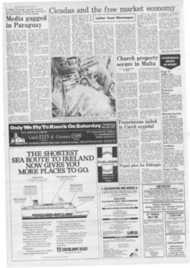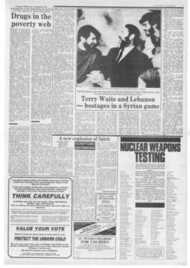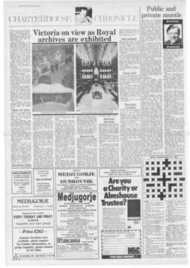Page 1, 29th May 1987
Page 1

Report an error
Noticed an error on this page?If you've noticed an error in this article please click here to report it.
Tags
Share
Related articles
To Be Or Not To Be The True Church
Vatican Discusses Links With Kremlin
Cardinal Willebrands Becomes Archbishop Of Utrecht
Cardinal Raps Hope People
Vatican Dignitary In Unity Talks
Willebrand's US talks rekindles controversy
by Martin Newland FEARS about the Vatican's intentions regarding unity between the churches were highlighted earlier this month following two controversial addresses in America by Cardinal Johannes Willebrands which contrasted sharply with the official line taken by the Sacred Congregation for the Doctrine of the Faith on what constitutes the "true Church".
The cardinal, who is President of the Vatican Secretariat for the Promotion of Christian Unity, caused a commotion amongst American theologians by implicitly refuting the Vatican definition of the true Church, issued in 1985.
The storm centres around the interpretation of Vatican II texts on the Church which stated that the true Church "subsists in" the Roman Catholic Church.
Cardinal Willebrands contended that "Outside the Church there exists many elements of sanctification and truth which are gifts proper to the Church of Christ and therefore true ecclesial elements," confirming that mainline Christian churches are all members of the true Church.
Theologians attending his addresses commented how this view contradicted that of Cardinal Ratzinger's Sacred Congregation which, in a 1985 statement criticising outlawed Brazilian Liberation Theologian Fr Leonardo Boff, said that the "authentic meaning" of the conciliar text — Lumen gentium — was that "only elements" of the True Church exist outside the "visible structure" of the Catholic Church.
The Sacred Congregation further contended that the term "subsists in" was chosen precisely to make it clear that the one true Church was in fact the Roman Catholic Church.
Cardinal Willebrand's comments, given in Atlanta and Washington on May 5 and 8 respectively, rekindled lively criticism of the 1985 statement among noted theologians.
Fr Joseph Komonchak and Jesuit Fr Avery Dulles, both teaching at the Catholic University in Washington, came out in favour of the cardinal's statement that Christ's one Church "goes beyond the visible limits" of the Catholic Church", and spoke of the official view as "minimalising" the idea of how the other Christian churches are part of the true Universal Church.
American Jesuit Fr Francis Sullivan, who teaches at the Gregorian University in Rome and who publicly criticised the 1985 statement last year at the ecumenical Centre Pro Unione, dubbed the Vatican line as an "obvious repudiation" of the Vatican council's Decree on Ecumenism.
Noted American canon Lawyer and teacher at the Catholic University Ladislas Orsy sympathised with this view, commenting that he "would find it very difficult to find any other interpretation" of the conciliar texts on the subject other than that presented by Cardinal Willebrands in his Washington address.
"I was in Rome during the council and was following the debates closely", said Fr Orsy who also stated that cardinal Willebrand's speech was merely "elaborating on the obvious".
Consternation in ecumenial circles has been rife since the 1985 statement by the Sacred Congregation. The Rev Albert Outler of Southern Methodist University, who was an official observer at the council, described ecumenism as "dead in the water", due he said to "Romans in high places" trying to reinterpret the term "subsists in" to mean "coextensive with."
blog comments powered by Disqus










